- Submissions

Full Text
Research in Medical & Engineering Sciences
Comparative Analysis of Knee Joint Replacement and Stem Cells Therapy Treatment for Knee Osteoarthritis Using Statistical Techniques
Mueed Sultan1, Muhammad Mujtaba Shaikh2* and Narinder Parshad Chowdhry3
1Department of Biomedical Engineering, MUET, Jamshoro, Pakistan
2Department of Basic Sciences and Related Studies,MUET, Jamshoro, Pakistan
3Department of Biomedical Engineering, Pakistan
*Corresponding author: Muhammad Mujtaba Shaikh, Department of Basic Sciences and Related Studies, Mehran University of Engineering and Technology (MUET), Jamshoro, Pakistan,
Submission: February 08, 2020 Published: February 13, 2020

ISSN: 2576-8816Volume8 Issue4
Abstract
In order to evade surgical modality employed in knee osteoarthritis (OA), healthcare providers have developed knee cartilage regenerative techniques inducing stems cells. In this research, we compare two types of treatments to overcome knee osteoarthritis: knee replacement and stem cells therapy. The comparison on the basis of several aspects was established. The main concern of study was to assess recovery time, procedure cost, recovery rate, and invasiveness aspects on the basis of patients’ perceptions and reviews of experts. The results have effectively shown that the participants belonging from knee joint replacement surgery group were more exposed to invasiveness and had to suffer much more pain and complications as compared to the other group. Moreover, it was observed that participants belonging from stem cells therapy group were likely to agree on the better exploitation of advanced technology in the respective procedure as compared to the other group. Whereas, knee joint replacement surgery was seemed to be more effective for patients in the last stage of OA who were suffering complete disability and severe inflammation. Thereby, patients who were suffering from final stage of knee osteoarthritis were not likely to attain stem cells therapy, as it seemed to be inadequate for the particular case.
Keywords: Knee osteoarthritis; Knee replacement; Stem cells therapy; Statistical analysis
Introduction
Osteoarthritis (OA), a frequent occurring disease among the elderly people, causes disability and severe pain. Studies have shown, the weight bearing joints such as knee joint are more susceptible to osteoarthritis. The medications and physiotherapy are although effective, but at later stages patients are only left with an option to undergo total knee joint replacement [1]. In this aspect, the role of poor knowledge regarding the attribution of environmental factors and heredity cannot be overlooked in causing severe OA and great disability. Knee-joint replacement (KR) surgery is followed by severe joint pain, radiographic changes and the failure of alternative treatment modalities. Although weight and age are two common causes of knee OA but there are several additional factors, which are responsible for inducing the respective condition [2]. The total knee joint procedure is highly invasive, and patient has to suffer from great disability for several weeks after the procedure is done [3]. The need for adaptation of an alternative treatment modality seems crucial to reduce the invasiveness aspects. Studies also highlight an alternative method of treatment that is stem cells (SC) therapy. SC therapy is helpful in regeneration of the knee cartilage followed by reduction in the overall disability and pain [4]. The regenerative techniques seem not only less invasive but can also assure repeatability if needed with no or negligible side effects.
A number of studies have been devoted to study the effectiveness of both KR and SC treatments for knee OA. According to [1], knee OA patients most likely consider surgical options, and this led them to embarrassment. Patients with knee OA experience pain and disability along with lose in occupational activities. Similarly, in [2] total KR was outlined as the most common treatment for end stage knee OA [2]. The demand of total knee joint replacement procedure is expected to reach 3.48 million in a year by 2030 [2]. The performance of artificial knee joint through the patients’ biomechanical data based on the activities of walking, stepping up and down, sitting and rising from chair were monitored. The importance of developing instruments and techniques in order to attain enhanced artificial knee joint alignment cannot be overlooked. In [3], authors suggest utilizing CT scanner device for the identification of femoral head center more precisely. The report [4] identifies that hip and knee joint disorders are ranked as 11th greatest cause of disability worldwide. Knee disorders in cartilage if diagnosed earlier stage might overlook the danger of knee joint replacement.
The study [5] clearly evaluates the capability of adipose tissue-derived stem cells (ADSC) therapy to overcome the pain and disability in knee OA [5]. It further explains that approximately 20% of Knee joint replacement patients experience loss of function in the next 12 months of procedure. The report [6] elaborates the significance of implementing ADSC therapy techniques for SCD (Sickle cell disease) patients to overcome knee OA [6]. It was seen that procedure was safe and feasible and moreover the results were satisfactory. The pain and disability were decreased in 29 patient out of 33, whereas 4 patients claimed to have no significant change in pain or disability. In [7], the report discusses on the complications of procedure in acquiring plasma rich platelets. Authors focused on the interventions to motivate healthcare providers on adopting better and non-invasive means of treatment. The biological strategies for healing of tendon bone to overcome osteoarthritis was investigated in [8]. Some of the common biological strategies are stem cell therapy, tissue engineering, Injecting PRPs and gene transfer. Despite categorizing stem cell therapy to have promising potential in cartilage healing, the study also discusses its limitations. Authors demonstrate that long term effects of stem cells therapy are still scarce based on human study. The significance the SCs procedure repeatability approach was discussed in [9], thus there is no complication in repeating the procedure. Whereas, when it comes to knee joint replacement technique, the option to repeat the procedure is rather complicated and highly expensive. Therefore, in authors’ perception the aspects of efficacy and safety are rather missing in regard to knee replacement approach. In [10], authors highlight the efficacy of exercise by means of cost-utility analysis meant for adult population suffering osteoarthritis. The cost utility analysis was based over 514 participants, which helped to understand the effects of appropriate exercise over pain and disability caused by Knee OA. The analysis efficiently high spots the significance and welfares of acquiring appropriate exercise therapy in order to attain reduction in disability caused by knee OA. The work in [11] delivers clear understanding on the reliability aspects of stem cell therapy. The report’s outcomes are based on the data attained form patients’ 5-year follow-up. In some patients, the parameters declined in the respective time period as compared to improvements occurred in 6 months. Whereas, others had totally different case and no decline was observed in any of the parameter.
Due to limited capacity for natural cartilage, no treatment approach is that much effective [12]. The most reported means of treatment considered by patients are medications and physiotherapies before total joint replacement. In [12], it was also highlighted that the knee joint replacement is not recommended to patients’ underage of 55. In [13], the fact regarding SCs that most of the present studies are focused on tissue regeneration abilities was highlighted. While SCs can be utilized in regeneration of other body parts such as cartilage and bone. Its further highlights that any sort of disability occurred due to infection can be easily recovered using these stem cells. According to Author perception, apart from knee joint injury, stem cells can effectively play significant role in regeneration of knee cartilage.
The effects infusion and injection of concentrated adipose tissues in the decreased part are discussed in the respective study [14]. The authors illuminate that apart from surgical procedures, cell injection approach is rather more feasible and non-invasive. Although, the outcomes may vary according to the different variables such as condition, age and the cause of disease within the patient. The report [15] demonstrates the significance of primary and secondary prevention strategies to avoid knee osteoarthritis. Primary strategies include risk reduction techniques by avoiding exposure to certain injury. Whereas, secondary strategies entail early detection and treatment of factors which are significant in developing osteoarthritis. Meta-analysis based on 27000 individuals reveal that neuromuscular training programs are crucial in preventing ACL (Anterior cruciate ligament) injuries, which ultimately prevents osteoarthritis on later stage. The impacts of the heredity and environmental conditions on the patients’ knee OA were investigated in [16]. From the reports [16], it can be perceived that patients who experienced healthy environments were less likely to develop osteoarthritis problems as compared to others. Despite of the heredity conditions causing knee OA, the environmental impacts along with physical exercise helped the patients to reduce the rate of degeneration in knee joint.
The report [17] intended to cover the effects of total knee joint replacement on the quality of life of patients. In the particular regards, authors have utilized statistical techniques to understand the relation between quality of life of patients before and after the procedure. By means of statistical techniques, authors clearly reveal the improvement in quality of life of patients after the surgical procedure. While the cost effect analysis shows the cost and expenses increased for the patients who had scenarios of lower physical function and attained complete knee replacement as compared to others. In [18], the comparison between cost analysis and effectiveness over knee joint replacement procedure were anticipated. In authors perception and observation, the patients with 1st and 2nd stage of knee OA were likely to spend less amount of cost as compared to patients with 3rd and 4th stage of OA. In addition, the report also establishes the wellbeing of exercise, diet and weight reduction techniques to induce cost effective outcomes in the patients . The data sets were based on 325 patients with average age of 63. In this study, we intend to compare the perceptions of patients undergoing knee OA on their awareness of the types of treatments, mainly KR and SC therapy, and to assess the benefits of SC therapy over KR surgery using statistical techniques.
Material and Methods
Research methodology and data collection
The study is based on mix methodology hence both types of methods (qualitative and quantitative) were used for data collection and analysis. In order to attain qualitative data, four healthcare providers were interviewed. These healthcare providers were asked to provide their valuable feedbacks regarding both the treatment procedures employed to overcome knee OA. Furthermore, their opinions were also attained concerning the patient awareness perspectives regarding these two procedures. Whereas the quantitative data was achieved by means of questionnaires which encompassed several parameters based on the variables for acquiring a better perception on treatment procedures.
There were 17 patients, who belonged to SC therapy group. While 25 participants were from KR group. Hence, the total sample size was 42. The experts and patients belonged to hospitals from Karachi, Sindh, Pakistan. In total, 29 questions were asked from knee OA patients treated by KR and SC procedures. In Table 1, the list of variables and their nature are described. Expect age and weight of patients, all other variables were qualitative.
Statistical analysis framework
The data collected through questionnaires for 29 variables described in Table 1 have been analyzed by various statistical procedures to get meaningful information about perceptions of patients for knee OA treatment. Statistical analysis in terms of frequencies, descriptive parameters and graphs has been conducted. Comparative analysis of the perceptions of patients using parametric/non-parametric tests: randomness, normality, t-tests/Mann-Whitney-U were established. As such, the data analysis has been divided into following four phases. The SPSS software has been used to note all results, and then expert interpretation of the indicators obtained through statistical tools have been discussed in detail along with the results.
Phase I. Percentage frequency multiple bar charts: The percentage response of patients for all variables have been compared using percentage frequency multiple bar charts. These charts help in understanding the priority and distribution of patients’ perceptions on various aspects concerned with KR and SC procedures of treating knee OA.
Phase II. Randomness and normality: Screening the data on all variables for normality and randomness. The Runs and Kolmogorov-Smirnov tests have been at a level of significance, α = 0.05 for checking randomness and normality of the variables with both types of treatments, leading to the use of both tests 42 times. The hypotheses associated with these tests have been set as:
Null hypothesis, H0 : Data is random/normal.
Alternative hypothesis, H1 : Data is not random/ normal.
The p-values, which represent the probability of the likelihood of H0 or evidence in favor of H0 were noted, and the interpretation have been made on basis of following criteria.
- If p-value >\>α, then there is enough evidence to conclude that the data is random/normal.
- Otherwise, if p-value ≤α, then there is not enough evidence to conclude that the data is random/normal.
Phase III Type of test for inference: If data is both random and normal then we use parametric (Par) test, otherwise non-parametric (N-Par) test for inferences, like average perception comparison, correlation etc.
Phase IV Average perception comparison: Comparison of average (mean/median) response of patients of both types of treatments using sampling distribution of means and medians. In case of parametric cases, Students’ t-test with independent samples choice has been used at α=0.05 which compares whether the average response of patients with regard to arithmetic mean has been same or not for patients undergoing both types of treatments. On the other hand, Mann-Whitney-U test was used at α=0.05 to compare median perception of patients treated by KR and SC procedures on all variables in Table 1. In the case of these tests, the procedure to screen-out and infer about the average (mean/median) response in given below.
- Null hypothesis, H0: Average perception of KR and SC patients is same/there’s no significance difference between the response of both types of patients.
- Alternative hypothesis, H1: Average perceptions of KR and SC patients for a variable (aspect) significantly differ. If p-value >0.05, then there is enough evidence to conclude that the average response is same for both groups of patients, otherwise, there is not enough evidence to conclude that the perceptions are same for both groups for different variables in Table 1.
Results and Discussion
Corresponding to the phases I-IV in section 2.2, the results are presented here, and inferences about different aspects are established. Figures 1-29 illustrate the percentage variation in the response of patients of both treatments versus the selected options for all 29 variables asked through questions Q1-Q29 of Table 1. The age (years) and weights (kgs) of patients are shown in Figure 1 & 2. Most of the patients from SC therapy group belonged to forty-five years of age whereas most of the patients of KR group belonged to 60 years of age. Most of the SC therapy patients weighed 62kg whereas KR patients weighed 70kg mostly. Profession of patients in Figure 3 varied from teaching, management, drivers to housewives and businesspeople. It was seen that most of the patients in SC method belonged to management profession. On the other hand, KR and SC patients were largely related to outdoor, continuous sitting and indoor job descriptions. From Figure 4, it is apparent that most of the patients in stem cells therapy group were females whereas most of the patients in knee replacement surgery were male.
Table 1: List of variables and their nature.
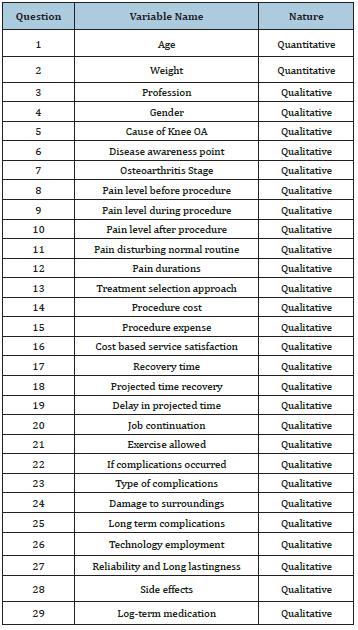
Figure 1: Comparison of age (years) of patients (Q1).
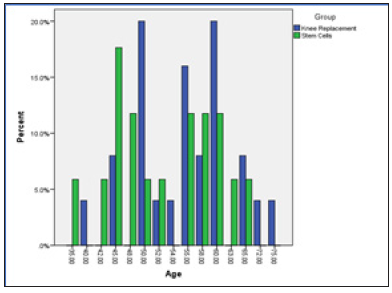
Figure 2: Comparison of weight (Kg) of patients (Q2).

Figure 3: Comparison of profession of patients (Q3).
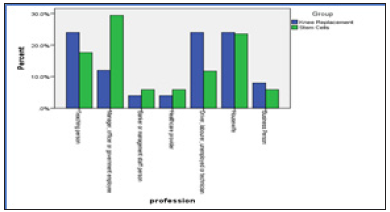
Figure 4: Comparison of gender of patients (Q4).

Figure 5: Comparison of cause of knee OA (Q5).

Figure 6: Comparison of the moment of realization of undergoing knee OA (Q6).

Figure 7: Comparison of stage of disease in patients (Q7).
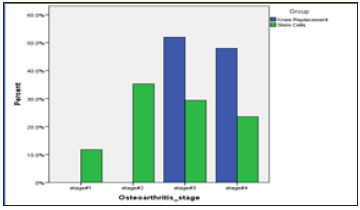
Figure 8: Comparison of pain level before treatment (Q8).

Figure 9: Comparison of pain level during treatment (Q9).
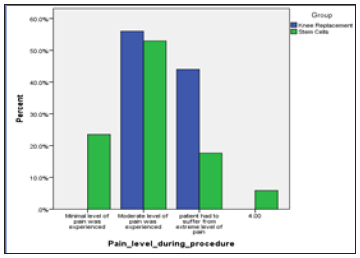
Figure 10: Comparison of pain level after treatment (Q10).

The cause of disease has been compared in Figure 5, which clearly depicts that the age was the most common cause for occurring of knee OA among both groups of patients. Figure 6 show that most of the SC patients had got disease awareness earlier than the patients from KR group. Figure 7 expresses about stage of knee OA at which the patients started to seek respective treatment procedures. KR patients experienced treatment procedure at stage 3 and 4, while SC patients acquired treatment at every stage with trend declining for SC as stages progress. The extent of pain level experienced by patients before, during and after the treatment has been compared in Figures 8-10. Before the procedures, most of the patients had to suffer from moderate to extreme level of pain, see Figure 8. From Figure 9, it appears that most of SC patients had suffered moderate level of pain during procedures, while there were several KR patients who suffered extreme level pains. It is clear from Figure 10 that most of SC patients were likely to experience minimal level of pain whereas least number of patients in KR group suffered minimal level of pain after procedure.
Figure 11: Comparison of pain disrupting routine (Q11).
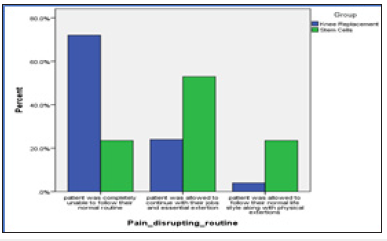
From Figure 11 a clear perception can be attained regarding levels of pain disrupting normal routine of patients. The normal routines of KR patients were extremely disturbed, and they faced great disability for certain duration after procedure. An understanding on the durations of pain experienced by patients after procedure can be attained through Figure 12. SC patients were likely to experience pain less than a month while most of the KR patients had suffered three to six months of pain. In Figure 13, the insights on patients’ approach to choose respective treatment procedure can be sensed. It was patients’ perception that SC therapy expresses higher success rates. While a class of KR patients were seemed to have no other choice.
Figure 12: Comparison of pain duration of treatments (Q12).

Figure 13: Comparison of treatment selection (Q13).

In regard to procedure cost, it is observed from Figure 14 that the SC therapy procedure was relatively cheaper as compared to KR procedure. Through Figure 15, we can attain a perception regarding patients’ ability to bear their procedure expenses. Most of SC patients did not require to borrow any finance whereas KR patients were likely to borrow little finance. It is apparent from Figure 16 that patients from both groups seemed to be satisfied from the services they received. However, the number of patients who were not satisfied with the offered services were more in SC group.
Figure 14: Comparison of procedure cost (Q14).
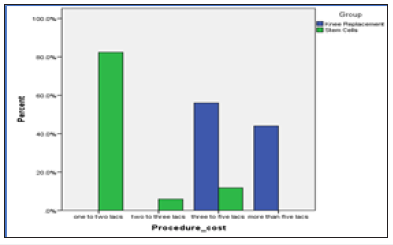
Figure 15: Comparison of borrowing finance for treatment (Q15).
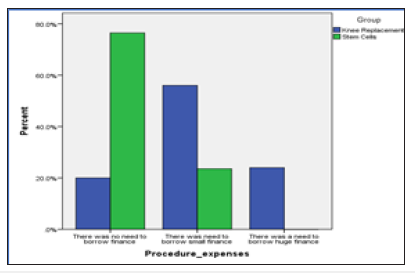
Figure 16: Comparison of cost-based service satisfaction (Q16).
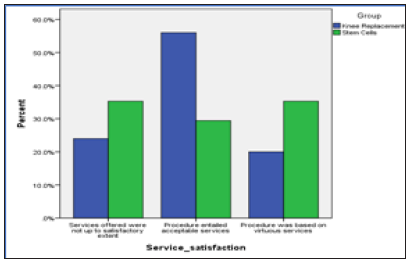
The concerns of recovery time can be established from Figure 17. It can be observed that recovery time solely depends on the condition of patients in SC therapy whereas KR patients took 3 to 6 months for recovery from disease. Figure 18 shows that patients of KR recovered in expected time whereas SC therapy patients took more than projected time period for recovery. In Figure 19, KR patients data exhibit minimum delay in expected time period. On the contrary, SC therapy data shows that many patients experienced delay in their projected time of recovery. The delay in time for SC is apparent due to the time required for regeneration of knee cartilage and its health.
Figure 17: Comparison of recovery time from disease (Q17).
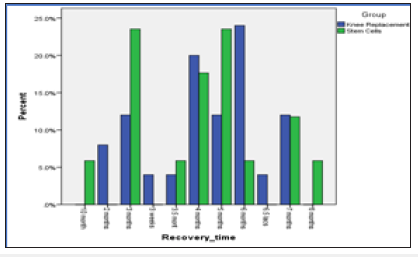
Figure 18: Comparison of whether recovered in projected time (Q18).

Figure 19: Comparison of delay in recovery(Q19).
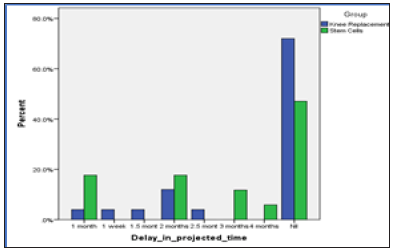
From Figure 20, it is clear that SC patients were able to carry on their jobs while KR patients were not allowed to continue their job. Figure 21 shows percentage of exercise permitted to patients of both types. It shows variations in data and can be related to the perception of patients about the recovery time. Figure 22 shows that the patients undergoing KR suffered complications more than SC patients. The types of procedure complications are described in Figure 23. Data show that 80% SC patients were free from complication while a small group faced complications. On the other hand, majority of KR patients were also free from complications, but many suffered from severe pain, swelling and infection. Figure 24 depicts that SC procedure caused least damage to surrounding structures, but data of KR patients shows variations. For the case of long-term complications, Figure 25 depicts that the patients of SC therapy got no long-term complications however, patients of KR – although a small group – faced some long-term complications.
Figure 20: Comparison of job continuation immediately after the treatment(Q20).

Figure 21: Comparison of extent to which exercise and movements allowed (Q21).
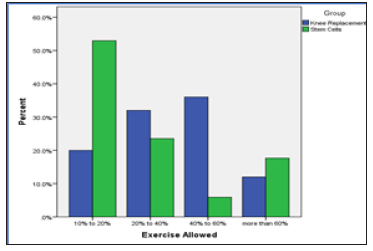
Figure 22: Comparison of whether any complications during procedure(Q22).

Figure 23: Comparison of type of complication (Q23).

Figure 24: Comparison of damage to surrounding structure (Q24).

Figure 25: Comparison of whether any long-term complications (Q25).

Figure 26 describes about the technology used in both procedures. Data shows that SC therapy used more advanced equipment than KR procedure. Regarding long-lasting and reliability, as in Figure 27, both procedures were found to be reliable and long-lasting with not much of a difference. Figure 28 shows more than 60% SC patients had no side effects after the procedure and only small percentage had to face complication like infection. On the other hand, 50% KR patients after getting artificial knee needed support for walking and small percentage of people faced side effects like severe pain, prolong bed rest and ulcer. When asked about whether patients had to take any long-term medications as shown in Figure 29, a substantial contrast between patients’ perceptions of both treatments was observed. Mostly, SC patients were not asked to take medicines while the KR patients were on medication for a long period of time.
Figure 26: Comparison of quality of equipment (Q26).

Figure 27: Comparison of whether procedure was long-lasting and reliable (Q27).

Figure 28: Comparison long-term side effects (Q28).
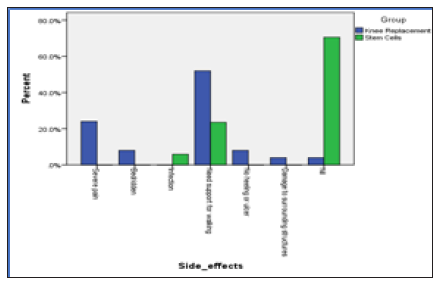
Figure 29: Comparison of whether long-term medications (Q29).
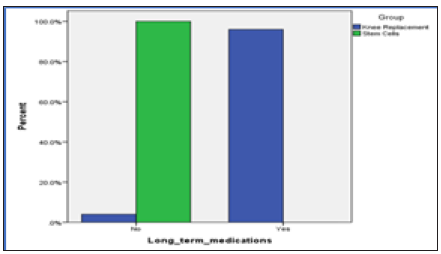
The results obtained in phase-II by using Runs and Kolmogorov-Smirnov tests to screen the variables for randomness and normality, respectively so that the respective type of test - Par or N-Par-could be identified are shown in Table 2. If p-value was higher than 0.05 in a particular test for a particular variable, then variable was found to be random and/or normal, and Yes (Y) is labeled besides, otherwise No (N) is mentioned in Table 2.
For the case of parametric tests, the data of variables have to be both random and normal in both treatments, otherwise non-parametric test can be applied for further analysis. The details of this selection are described in phase-III. It can be seen from Table 2 that only two variables: Age and Weight were the parametric types, all others being non-parametric cases. It is always imperative to infer about the population parameters on the basis of sample data to see whether the results obtained from sample also represent the characteristics of population [19]. Since the number of patients in the data was 17 for SC and 25 for KR type, the comparison performed in phase-I may or may not lead to the same insights if more patient’s data could be added. To have an idea on whether the perceptions of all SC and KR type patients if surveyed in future in the same meaner under similar conditions will change or remain same as the sample comparisons, a broader examination of data on the basis of sampling distribution techniques has been used in phase-IV as also detailed in [19].
Table 2:
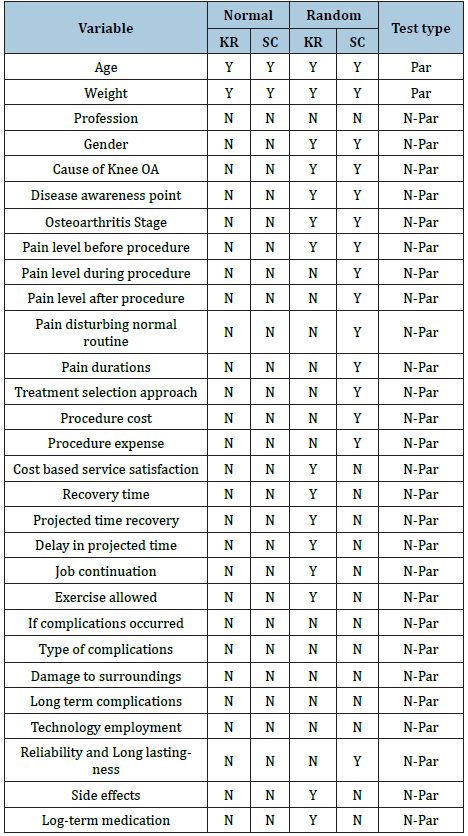
By using t-test on parametric type cases and Mann-Whitney-U test on remaining at 0.05 level of significance, statistical evidence on the average perceptions of all SC and KR patients who might be surveyed in future on same aspects have been gathered to broaden the implications of this study. Figure 30 show the observed p-values for all variables obtained by using t/MW-U tests, and a borderline at a level of significance 0.05. As described in phase-IV framework, the average perceptions of any KR and SC patient, if surveyed, will have significant difference if p-value is lower than 0.05, otherwise the average perception or response would be considered same. It can be seen From Figure 30 and Table 3 at 0.05 significance level that mean age-group of the patients was not significantly different, whereas there was a significant difference in their respective weights. Similarly, the median profession and gender has also been same. The difference in perceptions of patients about the cause of knee OA, awareness point and disease stage were also non-significant.
Figure 30: Comparison of average perceptions on basis of p-values for all variables.
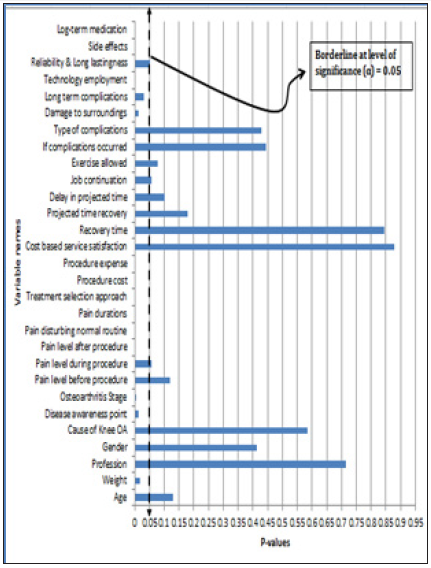
Regarding the level of pain before, during and after the treatment, there was significant difference in patients’ response in some cases. Before and during the procedures, the average perception about pain levels among the patients was almost same at 0.05 significance level, whereas after the procedures the extent of pain was significantly different. At 0.1 margin of significance, the pain level perceptions, however, has been different. The routine disturbance due to pain were also found to be significantly different for both SC and KR patients. The responses of patients on duration of pain were also significantly different. The selection approach of treatment was found to be significantly different as also shown in Figure 13.
On average, the patient’s perceptions about cost of procedure and whether they had to borrow loans to bear the expenses were also significantly different. On the other hand, the cost-based service satisfaction levels on average has been same. As demonstrated previously in phase-I the cost for SC therapy was significantly lower than KR process, yet the patients have same satisfaction level. While patients’ responses on time of recovery and projected recovery time had been same on average but there is an evidence of difference of opinion at a slightly higher significance level about their perception on possible delay in the time of recovery. Same is observed in cases of normal routine works after treatment in terms of job continuation and exercise allowed, and over-all responses about long lastingness and reliable effects. The patient’s responses were on average same at a lower significance level, whereas at 0.1 level of significance (as in Table 3) they are likely to differ significantly. The responses received by asking whether there had been any complications and the types of complications show non-significant difference on average for both types of patients. There was a significant difference in median responses of patients when asked about whether the treatment caused damage to surrounding structures, had there been any long-term complications, the technological level of equipment used in procedures, side effects of the treatments and was long term medication compulsory.
Table 2: Results on any significant difference between the perceptions of SC and KR patients.

The over-all comparison was also repeated at a level of significance 0.1 to see if there had been a slight chance of change in perceptions of SC and KR patients. The results had almost been same at 0.05 and 0.1 levels as discussed above, except in the cases of variables in Q9, Q19-21 and Q27. In these variables increasing level of significance from 0.05 to 0.1 changed the interpretation into the patients showing significant difference instead of no difference on average. The results discussed in phase-IV procedure, wherever show change in average perception must be seen together with the corresponding results in phase-I. Such correspondence enables to conclude that the difference of perceptions among both types of patients show the precedence of less invasive SC therapy procedure over the highly invasive KR surgery.
The findings identify alternative options available to overcome knee osteoarthritis. Based on the statistical analysis, it was prominent that patients who were suffering initial level of knee OA were likely to attain great benefit. SC therapy helped the patients to restore their lifestyles and routines without undergoing surgical interventions. However, the SC therapy seemed ineffective on the patients who were suffering final stage of OA, they were only left with the option to acquire total knee replacement. Considering the association of risks and side effects with highly invasive procedure of total knee joint replacement, patients showed their immense satisfaction on the therapeutic procedure. On the contrary side, the lack of awareness regarding advanced medical procedures led the patients to overlook other opportunities of treatment. With this optimistic statistical analysis, it would be rather easy to educate and motivate the patients to decide for alternative medical techniques. Moreover, the awareness can also play enormous role in adopting better healthcare facility.
Conclusion
Non-surgical procedures have gained vast significance in healthcare sector. Regardless of the cost and outcomes, peoples are more interested to acquire remedies that can be helpful to overcome certain disease without surgery. Similarly, the study was conducted to compare total knee joint replacement method with stem cells therapy and the outcomes were optimistic. The study shows that therapeutic procedure was rather less expensive and more effective at initial stages of knee OA. In addition, the therapeutic procedure has the ability to be repeated more than once with no apparent side effects. While the case of KR procedure was different, there were more chances of complications in recurrence of disease. Although, surgery is the only option for patients suffering last stage of OA, the further development in tissue engineering and similar therapeutic procedures will soon coup with the particular.
References
- Man A, Davis A, Webster F, Polatajko H (2017) Awaiting knee joint replacement surgery: An occupational perspective on the experience of osteoarthritis. Journal of Occupational Science 24(2): 216-224.
- Dowsey MM, Pandy M, Young TJ, Gray H, Guan S, et al. (2018) A blinded, three-arm randomised trial assessing joint function and measuring three-dimensional knee joint kinematics in individuals six months after a total knee joint replacement; comparing a medially stabilized design, to standard fixed bearing conventional designs-posterior stabilizing and cruciate retaining. Int J Clin Trials 5(1): 37-45.
- Zaima H, Hashida M, Kyocera (2019) Measuring instrument for use in artificial knee joint replacement surgery. U.S. Patent 10,322,013.
- Davies BM, Snelling SJ, Quek L, Hakimi O, Ye H, et al. (2017) Identifying the optimum source of mesenchymal stem cells for use in knee surgery. Journal of Orthopaedic Research 35(9): 1868-1875.
- Freitag J, Bates D, Wickham J, Shah K, Huguenin L, et al. (2019) Adipose-derived mesenchymal stem cell therapy in the treatment of knee osteoarthritis: a randomized controlled trial. Regenerative Medicine 14(3): 213-230.
- Daltro G, Franco BA, Faleiro TB, Rosário DA, Daltro PB, et al. (2018) Use of autologous bone marrow stem cell implantation for osteonecrosis of the knee in sickle cell disease: A preliminary report. BMC Musculoskeletal Disorders 19(1): 158.
- Levy DM, Petersen KA, Vaught MS, Christian DR, Cole BJ (2018) Injections for knee osteoarthritis: corticosteroids, Visco supplementation, platelet-rich plasma, and autologous stem cells. Arthroscopy. The Journal of Arthroscopic & Related Surgery 34(5): 1730-1743.
- Hao ZC, Wang SZ, Zhang XJ, Lu J (2016) Stem cell therapy: A promising biological strategy for tendon-bone healing after anterior cruciate ligament reconstruction. Cell proliferation 49(2): 154-162.
- Freitag J, Bates D, Boyd R, Shah K, Barnard A (2016) Mesenchymal stem cell therapy in the treatment of osteoarthritis: reparative pathways, safety and efficacy-a review. BMC Musculoskeletal Disorders 17(1): 230.
- Kigozi J, Jowett S, Nicholls E, Tooth S, Hay EM, et al. (2018) Cost-utility analysis of interventions to improve effectiveness of exercise therapy for adults with knee osteoarthritis: the BEEP trial. Rheumatology Advances in Practice 2(2): 18.
- Davatchi F, Sadeghi A, Mohyeddin M, Nikbin B (2016) Mesenchymal stem cell therapy for knee osteoarthritis: 5 years follow‐up of three patients. International Journal of Rheumatic Diseases 19(3): 219-225.
- Damia E, Chicharro D, Lopez S, Cuervo B, Rubio M, et al. (2018) Adipose-derived mesenchymal stem cells: Are they a good therapeutic strategy for osteoarthritis. International Journal of Molecular Sciences 19(7): 1926.
- Riggs A (2017) The use of stem cells and their regenerative properties in the treatment of cartilage and bone disorders.
- Roato I, Belisario DC, Compagno M, Lena A, Bistolfi A, et al. (2019) Concentrated adipose tissue infusion for the treatment of knee osteoarthritis: clinical and histological observations. International Orthopaedics 43(1): 15-23.
- Roos EM, Arden NK (2016) Strategies for the prevention of knee osteoarthritis. Nature Reviews Rheumatology 12(2): 92.
- Magnusson K, Hagen KB (2016) Hereditary and environmental factors causing total joint replacement due to hip and knee osteoarthritis–a twin registry based prospective cohort study. Norsk Epidemiologi 26(1-2).
- Ferket BS, Feldman Z, Zhou J, Oei EH, Bierma Z, et la. (2017) Impact of total knee replacement practice: cost effectiveness analysis of data from the Osteoarthritis Initiative. BMJ 356: 1131.
- Rosen J, Niazi F, Dysart S (2019) Cost-effectiveness of treating early to moderate stage knee osteoarthritis with intra-articular hyaluronic acid compared to conservative interventions. Advances in Therapy, pp.1-9.
- Memon AJ, Shaikh MM (2016) Confidence bounds for energy conservation in electric motors: An economical solution using statistical techniques. Energy 109: 592-601.
© 2020 Muhammad Mujtaba Shaikh. This is an open access article distributed under the terms of the Creative Commons Attribution License , which permits unrestricted use, distribution, and build upon your work non-commercially.
 a Creative Commons Attribution 4.0 International License. Based on a work at www.crimsonpublishers.com.
Best viewed in
a Creative Commons Attribution 4.0 International License. Based on a work at www.crimsonpublishers.com.
Best viewed in 







.jpg)






























 Editorial Board Registrations
Editorial Board Registrations Submit your Article
Submit your Article Refer a Friend
Refer a Friend Advertise With Us
Advertise With Us
.jpg)






.jpg)














.bmp)
.jpg)
.png)
.jpg)










.jpg)






.png)

.png)



.png)






